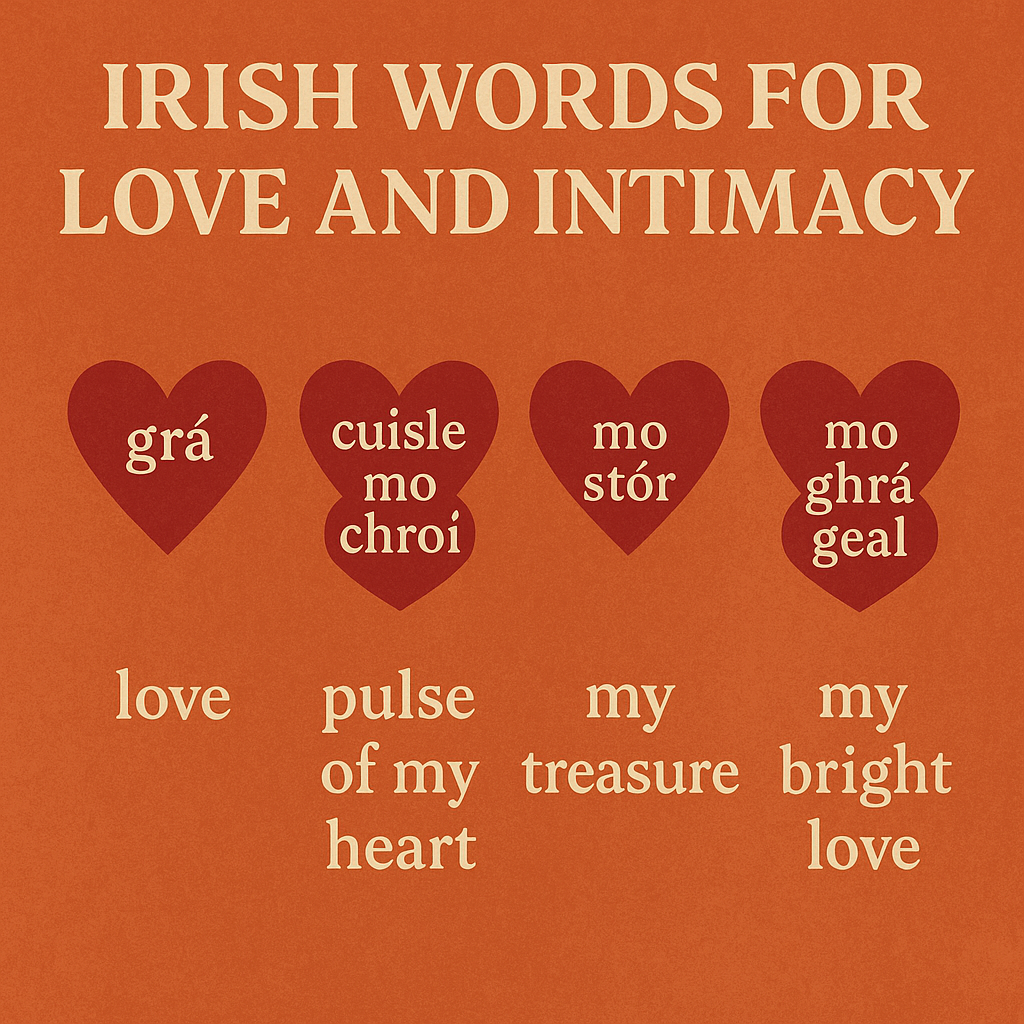
Listen up, you lovers of language, you rebels with a cause, you sons and daughters of the Irish diaspora and beyond!
The Irish language isn’t just a collection of lilting words for poetry or prayer—it’s a living, breathing beast, pulsing with the raw energy of desire, wit, and unapologetic humanity.
Forget the stereotype of a prudish, buttoned-up Ireland. The Irish slang for sex and sexuality is as bold as a pint of stout, as sharp as a Kerryman’s tongue, and as vibrant as a Dublin street on St. Patrick’s Day.
From the Gaeltacht’s windswept shores to the digital wilds of Twitter, the Irish language—Gaelic, Gaeilge, call it what you will—has a lexicon for love, lust, and everything in between that’ll make you laugh, blush, and maybe rethink everything you thought you knew about the Emerald Isle’s soul.
This isn’t your granny’s Irish lesson. This is about the Irish words for sex, the phrases that capture the heat of the moment, the cheeky slang for sex toys, and the terms that describe those who can’t get enough of the bedroom tango.
We’re diving deep into the work of Dáithí Ó Luineacháin, a scholar who roamed the Gaeltacht collecting words that range from playful to downright provocative.
We’ll explore the Twitter account @Collaiocht, a treasure trove of these terms, and we’ll ask: how does a language so ancient speak so boldly about modern desire? So, grab a seat, maybe a whiskey, and let’s tear into the Irish sexuality terms that prove Gaelic is anything but tame.
The Gaeltacht’s Secret Sauce: A Language That Doesn’t Hold Back
The Irish language, born in the rugged hills and salty air of the Gaeltacht, isn’t afraid to get down and dirty. The Gaeltacht—those Irish-speaking pockets of Donegal, Galway, Kerry, and beyond—has always been a place where words carry weight, where stories are spun with grit and grace.
And when it comes to sex and sexuality, the language doesn’t shy away. Thanks to scholars like Dáithí Ó Luineacháin, whose book Ó Ghlíomáil go Giniúint: Foclóir na Collaíochta is a goldmine of Irish phrases, we’ve got a dictionary that’s as unfiltered as a pub brawl.
This isn’t about making up words to sound clever; it’s about capturing the living, breathing language of real people—farmers, fishermen, and storytellers who spoke with a twinkle in their eye and a fire in their belly.
Take a word like gliodaí. It’s not just a flirt; it’s someone who’s got charm dripping off them, the kind of person who could sweet-talk a banshee. Or gealt ghnéis, a term for someone whose mind is a one-way street to the bedroom—a phrase that cuts through with the precision of a Galway hooker slicing the waves. Then there’s oirnis, the Irish word for a sex toy, proving that even in the 19th century, the Gaeltacht wasn’t above a bit of playful innovation. These aren’t just words; they’re snapshots of a culture that embraced desire with a wink and a nod, long before Ireland’s modern sexual revolution.
@Collaiocht: The Twitter Torchbearer of Irish Sexual Slang
Enter @Collaiocht, a Twitter account that’s been shining a light on these spicy Irish Gaelic terms since its creation.
The curator, a passionate defender of the language’s authenticity, spoke of their mission was clear: cut through the noise of half-baked translations and share the real deal. “I saw lots of talk on Twitter about sex and the language around it,” they said, “but much of it was inaccurate, spread by folks who didn’t know the living Irish of the Gaeltacht.”
Instead of arguing, they started @Collaiocht to set the record straight, drawing every word and phrase from Ó Luineacháin’s dictionary. No made-up terms, no clever quips for clout—just the raw, unfiltered truth of the Irish language dictionary.
The account, though dormant in recent years, is a treasure trove for anyone curious about Irish sex terminology. From terms for body parts to phrases for sexual acts, @Collaiocht lays it bare, proving that the Irish language has a vocabulary as diverse as its landscapes. But it’s not just about shock value.
The curator’s goal was to preserve the language’s authenticity, to show that Gaelic speakers didn’t need to borrow from English to talk about desire—they had their own words, honed over centuries in the pubs and homes of the Gaeltacht.
The Man Behind the Words: Dáithí Ó Luineacháin’s Legacy
Dáithí Ó Luineacháin wasn’t just a scholar; he was a linguistic adventurer, a man who wandered the Kerry Gaeltacht and beyond, collecting words like a botanist gathers rare plants.
His book, Ó Ghlíomáil go Giniúint, is a testament to the Irish language’s ability to capture every facet of human experience, from the sacred to the scandalous. Ó Luineacháin didn’t just rely on oral tradition; he scoured printed texts, old manuscripts, and dialects from across Ireland to build a dictionary that’s as much a cultural artifact as it is a linguistic resource.
But let’s not sugarcoat it—some of Ó Luineacháin’s findings are rough around the edges. Terms like gamhain, used for an effeminate man, or Muireann i mbríste, a jab at women who defied traditional roles, reflect the attitudes of a specific time and place.
The phrase an bhfuil náire ort?—literally “are you shamed?”—as a way to ask if a woman is pregnant, carries a sting that feels outdated in today’s Ireland. Critics have pointed out that Ó Luineacháin’s work, compiled over 20 years ago, lacks input from women and the LGBTQ+ community, and they’re not wrong. The Gaeltacht of the early 2000s wasn’t exactly a hotbed of progressive discourse, and Ó Luineacháin’s sources—mostly men—reflected that reality.
Still, the curator of @Collaiocht defends the work, not as a perfect record but as a snapshot of the language as it was spoken. “Dáithí didn’t speak to many women because they didn’t speak to him,” they explained. Picture a young Dublin scholar asking elderly Gaeltacht women about vulgar slang—it’s no surprise they clammed up. But that doesn’t diminish the value of what Ó Luineacháin captured. It’s a starting point, a foundation that begs for a modern update—one that includes more voices, more perspectives, and a lot less judgment.
Why the Irish Language Embraces Sex with Swagger
The Irish culture has always been one of contradictions—devout yet defiant, poetic yet earthy. The Irish language reflects that duality, weaving together the sacred and the profane with a kind of fearless joy. Unlike English, which often cloaks sex in euphemisms or shame, Irish Gaelic dives in headfirst.
Words like collaíocht itself—meaning sexuality or carnality—carry a weight that’s both sensual and unapologetic. This isn’t a language that whispers about desire; it shouts it from the rooftops, with a laugh and a clink of glasses.
Compare this to other Twitter accounts like @TheIrishFor, which translates modern terms, or @AnDuinnineach, which digs into Fr. Patrick S. Dineen’s 1927 Foclóir Gaedhilge-Béarla.
These accounts are brilliant, but they’re often more academic, more focused on the nuts and bolts of language. @Collaiocht, by contrast, is a rebel with a cause, shining a light on the parts of Irish that make you blush or chuckle.
It’s not about being crude; it’s about being real, about showing that the Irish language can handle the messiness of human desire with the same grace it brings to poetry or prayer.
The Evolution of Irish Sexual Slang: Past Meets Present
Ireland has changed since Ó Luineacháin roamed the Gaeltacht. The country that once blushed at the mention of sex now celebrates marriage equality, reproductive rights, and a more open dialogue about desire.
The Irish language, ever adaptable, is evolving too. New terms are emerging, and old ones are being reexamined through a modern lens.
The curator of @Collaiocht acknowledges this shift: “It’s time for another scholar to update the dictionary, to record the living language of the Gaeltacht today, with more input from women and the gay community.”
Imagine a new Foclóir na Collaíochta, one that captures the slang of Dublin’s queer scene, the banter of Galway’s youth, or the stories of women who’ve always had something to say but weren’t always heard.
The Irish language isn’t static; it’s a river, flowing from the past into the future, carrying the voices of all who speak it. Terms like gliodaí and oirnis might still have a place, but they’d sit alongside new words, new stories, new ways of expressing what it means to love, lust, and live in modern Ireland.
FAQs: Decoding the Irish Language of Love and Lust
What are some Irish words for sex and sexuality?
The Irish language is rich with terms for desire. Gliodaí means a flirt, someone with charm to spare. Gealt ghnéis describes a person obsessed with sex. Oirnis is a cheeky term for a sex toy, while collaíocht refers to sexuality or carnality itself. These words, drawn from Dáithí Ó Luineacháin’s dictionary, reflect the Gaeltacht’s bold approach to intimacy.
Why does the Irish language have such vivid sexual slang?
The Irish language, rooted in the Gaeltacht’s earthy culture, doesn’t shy away from human experience. Unlike English’s often euphemistic approach, Irish Gaelic tackles sex with wit and directness, reflecting a people who’ve always balanced reverence with rebellion. From oirnis to gealt ghnéis, these terms capture the raw humanity of desire.
Is Dáithí Ó Luineacháin’s dictionary still relevant?
Yes, but it’s a product of its time. Ó Ghlíomáil go Giniúint captures the Gaeltacht’s language from over 20 years ago, including terms like gamhain (effeminate man) that feel outdated. It’s a valuable snapshot, but a modern update with more diverse voices is needed to reflect today’s Ireland.
What’s the deal with @Collaiocht on Twitter?
@Collaiocht is a Twitter account dedicated to sharing Irish sex terminology from Ó Luineacháin’s dictionary. Started to combat inaccurate translations, it offers authentic terms and phrases, from playful to provocative, celebrating the Irish language’s unfiltered take on sexuality.
How has the Irish language evolved in talking about sex?
As Ireland has embraced marriage equality and open discussions about sexuality, the Irish language is adapting. While older terms like an bhfuil náire ort? carry outdated connotations, new slang is emerging, reflecting a more inclusive, modern Ireland. The language remains a living, evolving force.
The Call for a New Chapter
The Irish language is no museum piece; it’s a living, breathing thing, as wild and resilient as the people who speak it. The work of @Collaiocht and Ó Luineacháin reminds us that Gaelic has never been afraid to tackle the messy, beautiful reality of human desire. But the story isn’t over. It’s time for a new generation of scholars, poets, and rebels to pick up the pen, to wander the Gaeltacht and the cities, to listen to the voices of women, the queer community, and everyone else who’s got something to say. The Irish language is ready for its next chapter—one that’s as bold, as raw, and as unapologetic as the people who keep it alive.
So, whether you’re a native speaker, a diaspora dreamer, or just someone who loves a good story, dive into the world of Irish slang for sex. Learn the words, share the laughter, and raise a glass to a language that’s never been afraid to speak its truth. The Irish language isn’t just surviving—it’s thriving, and it’s got a hell of a lot to say about love, lust, and everything in between.






